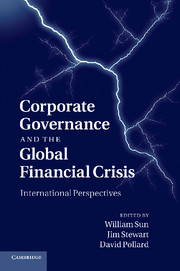Book contents
- Frontmatter
- Contents
- Figures
- Tables
- Contributors
- Acknowledgements
- 1 Introduction: rethinking corporate governance – lessons from the global financial crisis
- Part I The failure of the market approach to corporate governance
- Part II Ownership, internal control and risk management: the roles of institutional shareholders and boards
- Part III Post-crisis corporate governance: the search for new directions
- 12 Corporate governance, capital market regulation and the challenge of disembedded markets
- 13 The focus of regulatory reforms in Europe after the global financial crisis: from corporate to contract governance
- 14 The Great Recession's impact on global corporate governance
- 15 Corporate governance in the Islamic finance industry and mitigation of risks post the global financial crises
- 16 A holistic approach to corporate governance: lessons from the financial crisis and the way forward
- Index
- References
14 - The Great Recession's impact on global corporate governance
Published online by Cambridge University Press: 05 August 2011
- Frontmatter
- Contents
- Figures
- Tables
- Contributors
- Acknowledgements
- 1 Introduction: rethinking corporate governance – lessons from the global financial crisis
- Part I The failure of the market approach to corporate governance
- Part II Ownership, internal control and risk management: the roles of institutional shareholders and boards
- Part III Post-crisis corporate governance: the search for new directions
- 12 Corporate governance, capital market regulation and the challenge of disembedded markets
- 13 The focus of regulatory reforms in Europe after the global financial crisis: from corporate to contract governance
- 14 The Great Recession's impact on global corporate governance
- 15 Corporate governance in the Islamic finance industry and mitigation of risks post the global financial crises
- 16 A holistic approach to corporate governance: lessons from the financial crisis and the way forward
- Index
- References
Summary
‘Recessions reveal what the auditors missed.’
John Kenneth GalbraithThe Great Recession of 2008–9 is not a story of wholesale corporate governance failure. On the contrary, the evidence suggests that corporate governance for listed firms in most developed country markets has continued on a slope of gradual improvement of minority shareholder protections over the past decade, maintaining the momentum that it sustained during the 1990s.
It is true that the meltdown of a handful of large financial firms was the proximate trigger for the Great Recession, and that this meltdown, in turn, was the result of (among other sins) poor risk management supervision by the boards and perverse compensation structures for the managers of these firms. These cataclysmic failures of governance were an anomaly, however, and one limited to a small number of firms within the financial sector. In fact, indices of corporate governance for listed firms improved across the board during the 1990s, and this improvement continued right through the deep trough of the recession in 2008–9, although this pattern showed some divergence between developed and emerging markets.
- Type
- Chapter
- Information
- Corporate Governance and the Global Financial CrisisInternational Perspectives, pp. 312 - 347Publisher: Cambridge University PressPrint publication year: 2011



